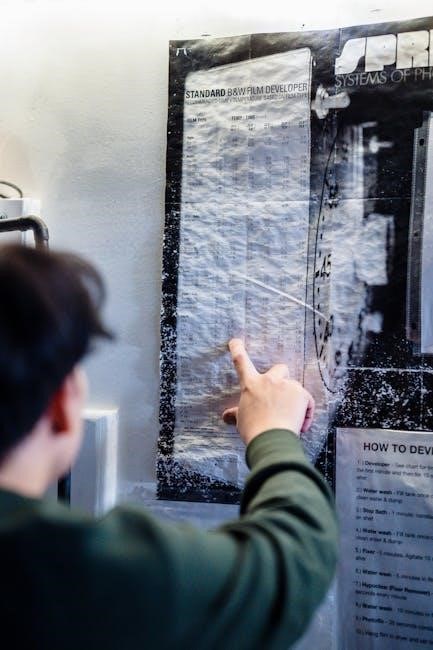musculoskeletal system study guide
The musculoskeletal system‚ comprising bones‚ muscles‚ and connective tissues‚ enables movement‚ supports the body‚ and protects internal organs. It is studied through detailed anatomy guides and textbooks.
1.1. Definition and Overview
The musculoskeletal system is an interconnected network of bones‚ muscles‚ and connective tissues that enables movement‚ provides structural support‚ and protects internal organs. It is studied through detailed anatomy guides and textbooks‚ such as those by Kotsyuba A. E. and Chertok V. M.‚ which focus on age-related changes. A comprehensive study guide by Dr. Ayisha Qureshi covers skeletal and smooth muscle anatomy‚ while resources like the Illustrated Pocket Anatomy offer visual learning tools for understanding this complex system.
1.2. Importance of the Musculoskeletal System
The musculoskeletal system is vital for movement‚ providing structural support‚ and protecting internal organs. It facilitates voluntary actions like walking and maintains posture. This system also produces blood cells and stores minerals‚ essential for overall health. Understanding its functions is crucial for nursing students and clinicians‚ as highlighted in study guides. Mastering its anatomy and physiology aids in diagnosing and treating musculoskeletal disorders‚ emphasizing its importance in both mobility and protective roles within the body.
1.3; Interconnectedness with Other Body Systems
The musculoskeletal system interacts closely with the nervous‚ circulatory‚ and endocrine systems. The nervous system controls muscle contractions‚ while the circulatory system delivers oxygen and nutrients to muscles and bones. The endocrine system regulates bone density through hormones like calcitriol. Additionally‚ the lymphatic system aids in waste removal‚ and the digestive system provides nutrients for muscle repair. This interconnectedness highlights the musculoskeletal system’s role in overall bodily functions and its dependence on other systems for optimal performance.

Anatomy of the Skeletal System
The skeletal system comprises 206 bones forming the body’s framework‚ providing support‚ protection‚ and facilitating movement through joints. Bones are lightweight yet strong‚ aiding blood cell production.
2.1. Structure and Function of Bones
Bones are dynamic tissues with a matrix of collagen and minerals‚ providing strength and flexibility. They support the body‚ protect organs‚ and facilitate movement through joints. Bones adapt to stress‚ remodeling constantly. Their structure includes compact and cancellous bone‚ periosteum‚ and marrow cavities. Functions extend to blood cell production and mineral storage‚ essential for overall health and mobility. Understanding bone anatomy is crucial for studying musculoskeletal physiology and clinical applications.
2.2. Classification of Bones
Bones are classified into five types based on shape and function: long‚ short‚ flat‚ irregular‚ and sesamoid. Long bones‚ like femurs‚ support body weight and enable movement. Short bones‚ such as carpals‚ provide stability. Flat bones‚ including the skull‚ protect organs. Irregular bones‚ like vertebrae‚ have unique shapes for specific roles. Sesamoid bones‚ such as the patella‚ reduce friction in joints. Understanding bone classification aids in studying musculoskeletal anatomy and its functional diversity in the human body.
2.3. Joints and Their Types
Joints‚ or articulations‚ are points where bones connect. They are classified into three main types based on movement: synarthroses (immovable)‚ amphiarthroses (slightly movable)‚ and diarthroses (freely movable). Synarthroses‚ like skull sutures‚ allow no movement. Amphiarthroses‚ such as intervertebral discs‚ permit limited motion. Diarthroses‚ including hinge joints (e.g.‚ knee) and ball-and-socket joints (e.g.‚ shoulder)‚ enable extensive movement. Understanding joint classification is crucial for studying musculoskeletal anatomy and its role in human mobility and function.
Muscular System Anatomy
The muscular system consists of over 700 muscles‚ primarily skeletal‚ smooth‚ and cardiac‚ working together to facilitate movement‚ maintain posture‚ and regulate body functions effectively.
3.1. Types of Muscles: Skeletal‚ Smooth‚ and Cardiac
The muscular system includes three types of muscles: skeletal‚ smooth‚ and cardiac. Skeletal muscles‚ attached to bones‚ enable voluntary movements and are striated. Smooth muscles‚ found in internal organs‚ function involuntarily‚ regulating processes like digestion. Cardiac muscle‚ exclusive to the heart‚ facilitates continuous‚ rhythmic contractions essential for blood circulation. Each type has distinct structures and roles‚ contributing to the body’s overall functionality and movement capabilities.
3.2. Structure of Skeletal Muscles
Skeletal muscles are organized into fascicles‚ bundles of muscle fibers wrapped in connective tissue. Each fiber contains myofibrils made of actin and myosin filaments‚ essential for contraction. The sarcolemma‚ a plasma membrane‚ surrounds each fiber‚ while sarcoplasm fills the interior. Tendons attach muscles to bones‚ enabling movement. This hierarchical structure allows skeletal muscles to generate force and facilitate precise‚ voluntary movements‚ integral to the musculoskeletal system’s function.
3.3. Muscle Fiber and Tissue Composition
Muscle fibers are long‚ multinucleated cells containing myofibrils‚ which are composed of actin and myosin filaments. These filaments slide past each other during contraction. Skeletal muscles are voluntary‚ while smooth and cardiac muscles are involuntary. Muscle fibers are surrounded by connective tissue‚ including the endomysium‚ perimysium‚ and epimysium. The sarcoplasm‚ a specialized cytoplasm‚ and sarcoplasmic reticulum support contraction. This complex structure enables muscles to generate force‚ essential for movement and bodily functions.

Physiology of the Musculoskeletal System
The musculoskeletal system’s physiology involves muscle contraction mechanisms‚ nerve impulses‚ and blood supply‚ enabling movement‚ stability‚ and organ protection through coordinated muscle and bone interactions.
4.1. Muscle Contraction and Relaxation Mechanisms
Muscle contraction occurs through nerve impulses triggering the sliding filament theory‚ where actin and myosin fibers interact. Relaxation happens when neurotransmitters cease and calcium ions are pumped back‚ allowing muscles to return to a resting state. This process is essential for movement and maintaining posture‚ with energy-efficient mechanisms ensuring optimal function and recovery.
4.2. Role of the Nervous System in Muscle Function
The nervous system controls muscle function through motor neurons transmitting signals from the brain or spinal cord. These signals activate muscle contractions‚ enabling voluntary movements and posture maintenance. Reflexes allow involuntary responses‚ ensuring quick reactions. The nervous system also regulates muscle tone and relaxation‚ preventing overexertion. This intricate communication network ensures precise and coordinated muscle activity‚ vital for overall mobility and bodily functions.
4.3. Blood Supply and Nutrition for Muscles and Bones
Adequate blood supply and nutrition are crucial for the health of muscles and bones. Muscles require oxygen and nutrients for energy production and repair‚ while bones need a rich blood supply for growth and mineralization. Nutrients like calcium and vitamin D are essential for bone density. Without proper circulation and nutrition‚ muscles may weaken‚ and bones can become brittle‚ leading to conditions like osteoporosis or muscle atrophy. Proper blood flow ensures optimal musculoskeletal function and overall health.

Connective Tissues in the Musculoskeletal System
Connective tissues‚ including ligaments‚ tendons‚ cartilage‚ and fascia‚ provide essential support‚ stability‚ and facilitate movement within the musculoskeletal system.
5.1; Ligaments and Tendons
Ligaments are tough‚ fibrous bands connecting bones to stabilize joints‚ while tendons link muscles to bones‚ enabling movement. Both are crucial for joint integrity and mobility‚ often studied in anatomy guides to understand their roles in the musculoskeletal system.
5.2. Function of Cartilage and Fascia
Cartilage acts as a cushion between bones‚ reducing friction and absorbing shock during movement. Fascia‚ a fibrous connective tissue‚ surrounds muscles and organs‚ providing structural support and enabling smooth movement. Both tissues play vital roles in maintaining joint health and musculoskeletal function‚ as detailed in anatomy guides and study materials for medical and nursing students.

Functions of the Musculoskeletal System
The musculoskeletal system facilitates movement‚ provides structural support‚ and protects internal organs. It enables mobility‚ maintains posture‚ and safeguards vital organs through coordinated muscle and bone function.
6;1. Movement and Mobility
The musculoskeletal system enables movement and mobility by coordinating the actions of bones‚ muscles‚ ligaments‚ and tendons. Skeletal muscles‚ attached to bones‚ generate force for voluntary movements like walking or lifting. Joints act as hinges‚ allowing bones to pivot and rotate‚ while ligaments stabilize these connections. This complex interplay facilitates precise movements‚ ranging from delicate finger gestures to powerful limb extensions. The system also maintains posture and balance‚ ensuring efficient locomotion and responsiveness to environmental demands.
6.2. Support and Stability
The musculoskeletal system provides structural support and stability to the body. Bones form the framework‚ while muscles‚ ligaments‚ and tendons maintain posture and prevent excessive movement. This system ensures the body remains upright and balanced‚ protecting internal organs like the brain‚ heart‚ and lungs. Proper alignment and strength enable efficient load distribution‚ minimizing the risk of injury and maintaining overall bodily integrity during rest and activity.
6.3. Protection of Internal Organs
The musculoskeletal system plays a critical role in protecting vital organs. Bones such as the ribcage shield the heart and lungs‚ while the skull safeguards the brain. The vertebral column encases the spinal cord‚ preventing damage. Muscles and connective tissues further absorb shocks and provide padding‚ ensuring organs remain safe during movement; This protective function is essential for maintaining internal health and preventing injury to delicate systems.

Clinical Relevance and Common Disorders
The musculoskeletal system is prone to injuries and diseases like arthritis‚ affecting movement and quality of life. Aging impacts muscle strength and bone density‚ increasing susceptibility to disorders.
7.1. Musculoskeletal Injuries and Diseases
Musculoskeletal injuries and diseases‚ such as fractures‚ arthritis‚ and tendinitis‚ affect millions. Conditions like osteoporosis and ligament sprains impair mobility and quality of life. Physical therapy and rehabilitation play a key role in recovery and management‚ emphasizing the importance of early diagnosis and treatment to restore function and reduce pain.
7.2. Aging and Its Impact on the Musculoskeletal System
Aging significantly affects the musculoskeletal system‚ leading to reduced muscle mass‚ bone density loss‚ and flexibility. Conditions like sarcopenia and osteoporosis become prevalent‚ increasing the risk of fractures. Regular exercise and maintaining an active lifestyle can help preserve muscle strength and bone health‚ promoting mobility and independence in older adults. Understanding these changes is crucial for developing effective strategies to support musculoskeletal health in aging populations.

Diagnostic Techniques for Musculoskeletal Conditions
Common diagnostic methods include imaging modalities like X-rays‚ MRIs‚ and CT scans‚ which provide detailed views of bones and soft tissues. Physical examinations also play a key role in assessing joint mobility and muscle function‚ aiding in accurate diagnoses of musculoskeletal disorders.
8.1. Imaging Modalities: X-rays‚ MRIs‚ and CT Scans
Imaging modalities like X-rays‚ MRIs‚ and CT scans are essential for diagnosing musculoskeletal conditions. X-rays provide clear images of bone structures‚ detecting fractures or degenerative changes. MRIs offer detailed visualization of soft tissues‚ including muscles‚ tendons‚ and ligaments‚ making them ideal for assessing injuries or inflammation. CT scans combine cross-sectional imaging with high resolution‚ useful for complex fractures or spinal issues. These non-invasive tools are critical for accurate diagnoses and treatment planning.
8.2. Physical Examination and Assessment
A thorough physical examination is crucial for diagnosing musculoskeletal disorders. It involves inspection‚ palpation‚ and assessment of range of motion‚ strength‚ and joint stability. Special tests‚ such as the McMurray test for knee injuries‚ help identify specific pathologies. Clinicians also evaluate gait and posture to detect imbalances or abnormalities. Accurate documentation of findings guides further diagnostic imaging or treatment plans‚ ensuring a comprehensive approach to patient care and management.

Rehabilitation and Management of Musculoskeletal Disorders
Rehabilitation involves physical therapy‚ targeted exercises‚ and pharmacological interventions to restore function and reduce pain. Surgery is considered when conservative methods fail to address the condition effectively.
9;1. Physical Therapy and Exercise
Physical therapy plays a crucial role in rehabilitation‚ focusing on exercises to enhance strength‚ flexibility‚ and mobility. Tailored programs often include stretching‚ aerobic activities‚ and resistance training to restore function and prevent further injury. Therapists may also incorporate manual therapy techniques to improve joint mechanics and reduce pain. Consistency in exercise routines is key to achieving long-term recovery and maintaining musculoskeletal health effectively.
9.2. Pharmacological and Surgical Interventions
Pharmacological interventions‚ such as NSAIDs and corticosteroids‚ are used to reduce inflammation and pain in musculoskeletal conditions. Biologic agents may be employed for severe cases. Surgical options‚ including arthroscopy or joint replacement‚ are considered when conservative treatments fail. These interventions aim to restore functionality‚ alleviate pain‚ and improve quality of life‚ often complementing physical therapy for comprehensive recovery. Timing and patient-specific factors guide the choice between these approaches.

Learning Resources for the Musculoskeletal System
Recommended textbooks and online tools provide comprehensive study materials for mastering the musculoskeletal system‚ offering detailed guides and interactive 3D models for enhanced learning.
10.1. Recommended Textbooks and Study Guides
Key textbooks include Anatomy of Age-Related Changes in the Human Musculoskeletal System by Kotsyuba A. E. and Chertok V. M.‚ and Rene Cailliet’s work for medical trainees. Acc Anatomical Chart Company’s Illustrated Pocket Anatomy offers detailed visuals‚ while Dr. Ayisha Qureshi’s guide provides structured learning. These resources cater to nursing students‚ medical clinicians‚ and anatomy enthusiasts‚ ensuring comprehensive understanding and practical application of musculoskeletal anatomy and physiology.
10.2. Online Tools and 3D Models for Visual Learning
Enhance your understanding with immersive 3D models and interactive tools like those offered by Kenhub‚ Cengage Learning‚ and Visible Body. These platforms allow users to explore the musculoskeletal system in detail‚ enabling visualization of bones‚ muscles‚ and connective tissues. Interactive 3D anatomy software provides layered dissection views‚ while video tutorials simplify complex concepts. Such resources are invaluable for nursing students‚ anatomy enthusiasts‚ and professionals seeking hands-on learning experiences to master musculoskeletal anatomy and physiology effectively.

Case Studies and Practical Applications
Explore real-world examples of musculoskeletal conditions‚ analyzing diagnosis and treatment. Practical applications deepen understanding‚ aiding students and professionals in mastering anatomy and clinical decision-making effectively.
11.1. Real-World Examples of Musculoskeletal Conditions
Examine real-world cases of musculoskeletal disorders‚ such as osteoporosis‚ fractures‚ and arthritis. These examples provide insights into symptoms‚ diagnosis‚ and treatment options. For instance‚ piriformis syndrome‚ a condition affecting the hip‚ illustrates the interplay between muscles and nerves. Such case studies are invaluable for students and professionals‚ offering practical learning opportunities to understand the complexities of musculoskeletal health and improve clinical decision-making skills. These examples highlight the importance of accurate diagnosis and tailored interventions in patient care.
11.2. Problem-Solving Exercises for Students
Engage with interactive exercises to test your understanding of the musculoskeletal system. Identify muscles and bones from illustrated diagrams‚ create labeled sketches of joints‚ and solve clinical scenario questions. For example‚ determine the affected structures in a patient with a shoulder injury or explain the muscle contractions involved in walking. These exercises enhance critical thinking and practical application of anatomical knowledge‚ preparing students for real-world clinical challenges in musculoskeletal health and rehabilitation.
The musculoskeletal system is vital for movement‚ support‚ and protection. This study guide provides a comprehensive understanding‚ aiding in clinical practices and academic success‚ while inspiring future research.
12.1. Summary of Key Concepts
The musculoskeletal system integrates bones‚ muscles‚ and connective tissues to enable movement‚ provide support‚ and protect organs. Its anatomy includes a skeletal framework‚ muscle types‚ and joints. Physiology involves muscle contraction‚ nerve control‚ and nutrient supply. Clinical relevance highlights injuries‚ aging impacts‚ and diagnostic tools like imaging and physical exams. Rehabilitation focuses on physical therapy and interventions. Understanding this system is crucial for healthcare professionals‚ students‚ and maintaining overall bodily function and mobility through exercise and nutrition.
12.2. Future Directions in Musculoskeletal Research
Future research in the musculoskeletal system focuses on advancing diagnostic tools‚ developing personalized therapies‚ and exploring regenerative medicine. Innovations like 3D modeling and virtual dissection enhance learning. Genetic engineering and stem cell therapies aim to repair damaged tissues. Wearable technology and AI-driven assessments could revolutionize monitoring and treatment. Collaborative efforts between clinicians‚ engineers‚ and scientists will drive progress‚ improving outcomes for conditions like osteoporosis‚ muscular dystrophy‚ and joint disorders‚ ensuring better quality of life for individuals worldwide.

